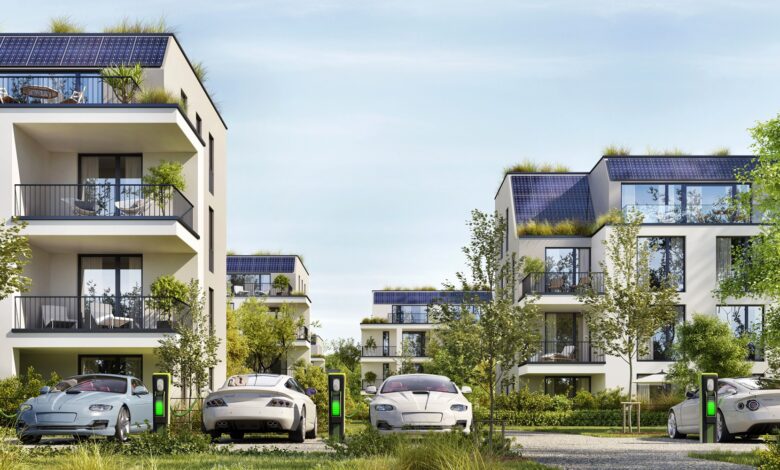
Part 1: How to be EV ready in your strata building
This article aims to guide strata community members through the process of making strata buildings EV-ready
Strata communities are realising the importance of adapting to support sustainable living. A significant part of this shift involves Electric Vehicles (EVs).
This article aims to guide strata community members through the process of making strata buildings EV-ready.
New regulations for EV charging in strata
As of October 2023, the National Construction Code in Australia mandates EV charging access in all newly constructed strata buildings. For new builds, this is relatively straightforward, but retrofitting existing buildings is more complex. It involves careful planning, not only for installing charging points, but also for ensuring that the electrical infrastructure, power load management, and billing systems can support EVs.
Understanding EV readiness
Being EV-ready means more than just installing EV chargers. It requires preparing your building with the right electrical and structural support for EV charging.
Key EV challenges for strata buildings
Existing strata buildings face some challenges:

Addressing the limited number of parking spaces
With the increasing adoption of EVs, strata communities must reconsider their parking strategies, especially in buildings where parking space is already scarce. The challenge is accommodating the growing need for EV charging stations without worsening the existing parking shortage.
Common property areas within strata buildings are often considered suitable for EV charging stations. However, retrofitting these areas requires careful planning to minimise disruption to existing parking arrangements and ensure equitable access for all residents. Additionally, it’s crucial to address or prevent ICEing (unauthorised parking in EV charging bays).
The phenomena of ICEing and range anxiety
Strata managers must understand ICEing and range anxiety when planning EV charging strategies.
ICEing: This occurs when non-EV (or Internal Combustion Engine) vehicles occupy EV charging bays, hindering access for EVs. It also includes situations where EVs park in dedicated charging bays without actively charging, known as “hogging.” Misusing these bays for general parking can be problematic.
Range anxiety: This is the fear of running out of charge before reaching a destination or the next charging station. Addressing ICEing is essential to prevent range anxiety among strata residents, ensuring a smooth transition to EVs.
Tackling the challenges for better EV adoption
ICEing is not only inconvenient but also discourteous. It’s a barrier to effective EV adoption and demands proactive measures. Addressing ICEing requires vigilant enforcement such as parking barriers and adopting parking systems.
Strata managers must implement clear policies regarding the use of EV charging bays and provide a reliable network of charging stations to support the growing number of EV users.
Upgrading electrical infrastructure for EV charging in strata
Introducing EV charging facilities in strata buildings requires changes in power consumption measurement. Many existing buildings lack the necessary electrical infrastructure, which may necessitate upgrades. The size and cost of these upgrades vary, depending on factors like the building’s age, size, and anticipated power consumption due to EV adoption. Evaluating the existing electrical system’s capacity, identifying constraints, and carrying out necessary enhancements are crucial for a smooth transition to EV-friendly infrastructure.

Streamlining cost allocation and billing for EV charging in strata
Developing an effective strategy for billing and cost allocation can be complex.
Effective cost allocation requires meticulous tracking. Strata buildings can track individual EV charging usage by enhancing building parking systems with smart parking bollards.
Often, strata managers are responsible for managing these costs. Key considerations include tracking individual usage, handling shared expenses, and determining fair ways to reimburse the strata corporation for electricity.
Balancing resident needs
Strata buildings must balance the needs of both EV and non-EV owners for parking. Conducting resident surveys and fostering open dialogue can help create a collaborative environment where diverse needs are understood and addressed. Engaging residents in decision-making ensures equitable parking availability for all, regardless of their vehicle type.
Regulatory and compliance considerations
Adapting to the EV trend requires understanding and complying with various regulations. This includes local building codes, council regulations, electrical standards, and safety protocols. Consulting with experts and regulatory bodies can offer valuable insights for seamless integration of EV charging facilities.
Proactive planning and collaboration
Proactive planning and collaboration are essential to tackle the complexities of EV charging installation. Customising solutions can make the process more effective. By implementing EV charging stations, strata buildings enhance amenities, resident satisfaction, and contribute positively to environmental sustainability.
EV readiness goes beyond regulatory compliance; it’s a step towards a greener, more sustainable future.
Adapted from article published in thatsMYspot.com.au – HERE
Article originally published in Resort News – subscribe HERE







